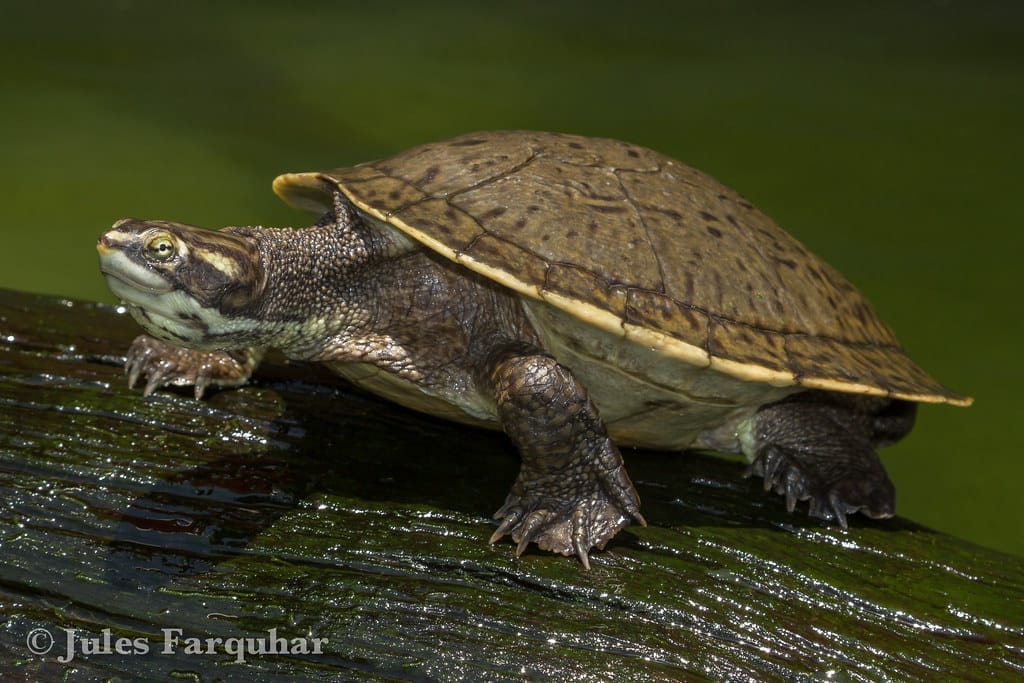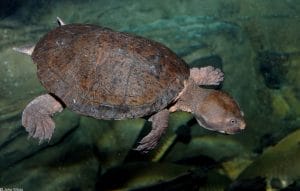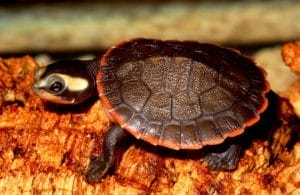Emydura tanybaraga (Northern yellow-faced turtle)
Home > Turtle Database > Emydura tanybaraga (Northern yellow-faced turtle)

Emydura tanybaraga is a freshwater turtle species native to Northern Australia. It is part of the Emydura genus, known for its semi-aquatic lifestyle and preference for slow-moving rivers and wetlands. This species stands out for its adaptability to varied habitats and its unique appearance.
Native To These Regions
Northern Territory (Australia)Native Turtle Species Map – Find Turtles by Region
Scientific Classification
- Kingdom: Animalia
- Phylum: Chordata
- Class: Reptilia
- Order: Testudines
- Family: Chelidae
- Genus: Emydura
- Species: Emydura tanybaraga
Common Names
- Northern Yellow-faced Turtle
- Gulf Snapping Turtle
This Hilarious Turtle Book Might Know Your Pet Better Than You Do
Let’s be real—most turtle care guides feel like reading a textbook written by a sleep-deprived zookeeper.
This one’s not that.
Told from the snarky point of view of a grumpy, judgmental turtle, 21 Turtle Truths You’ll Never Read in a Care Guide is packed with sarcasm, sass, and surprisingly useful insights.
And hey—you don’t have to commit to the whole thing just yet.
Grab 2 free truths from the ebook and get a taste of what your turtle really thinks about your setup, your food choices, and that weird plastic palm tree.
It’s funny, it’s honest, and if you’ve ever owned a turtle who glares at you like you’re the problem—you’ll feel seen.
Identification
Description
Emydura tanybaraga is a medium-sized turtle characterized by a yellow to cream-colored stripe running along its head and neck. It has a flat, streamlined shell that ranges from dark brown to olive, ideal for swimming in its aquatic habitat. The plastron (underside of the shell) is pale yellow or cream.
Sexual Dimorphism
Males tend to have longer tails and slightly narrower shells, while females are typically larger overall, especially in the abdominal area to accommodate egg-laying.
Check more turtles from the Emydura genus
Native Origin and Distribution
Geographical Range
This species is primarily found in the Gulf of Carpentaria region in Northern Australia. It inhabits freshwater rivers, lakes, and wetlands, thriving in both slow-moving and stagnant waters.
Preferred Habitat
Emydura tanybaraga prefers freshwater environments, including rivers, lagoons, and billabongs. It is commonly found in areas with plenty of aquatic vegetation, where it can hide and forage.
Behavior
Feeding Habits
This turtle is omnivorous, feeding on a variety of aquatic plants, small fish, insects, and mollusks. Its flexible diet allows it to adapt to seasonal changes in food availability.
Predators
Predators of Emydura tanybaraga include larger reptiles, such as crocodiles, as well as birds of prey and introduced species like feral pigs and foxes, which may target eggs and hatchlings.
Reproduction
Breeding Season
The breeding season for this species occurs during the warmer months, typically from September to March.
Reproductive Method
Females lay clutches of up to 15 eggs in sandy or loamy soil near water sources. The incubation period is around 70 to 90 days, depending on environmental conditions.
Conservation
Extinction Status
Emydura tanybaraga is currently listed as Least Concern by the IUCN, meaning it is not at immediate risk of extinction.
Threats
Primary threats include habitat loss due to agriculture, mining, and dam construction. Pollution and the introduction of invasive species also pose risks to this species’ survival.
Conservation Measures
Conservation efforts focus on habitat protection and monitoring of population numbers. Legal protection in Australia helps prevent overexploitation, and efforts to control invasive species are ongoing.
Economic Importance
While not a species widely traded or used commercially, Emydura tanybaraga plays a role in local ecosystems by controlling insect populations and maintaining healthy aquatic environments.
Interesting Facts
- The yellow stripe on the head of Emydura tanybaraga is one of its most distinguishing features, helping to camouflage it in the dappled light of its aquatic habitat.
- These turtles can live up to 40 years in the wild if conditions are favorable.
- Emydura tanybaraga is known for its strong swimming ability, using its webbed feet to navigate through fast-moving waters when necessary.

About Author
Muntaseer Rahman started keeping pet turtles back in 2013. He also owns the largest Turtle & Tortoise Facebook community in Bangladesh. These days he is mostly active on Facebook.













